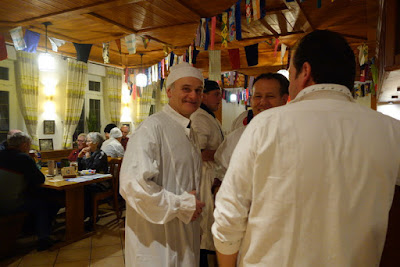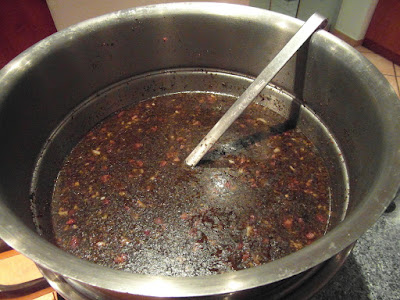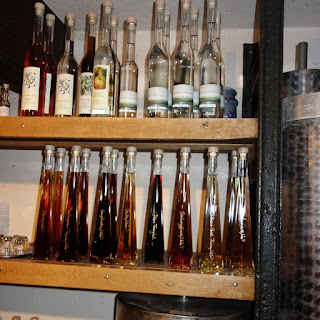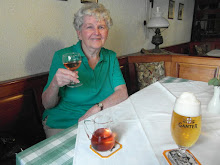
It's Christmas Eve. The last rays of light have dipped behind the mountain. The air is cold and clear. As we step outside, we can see our breath. A few flakes of snow are gently falling, silhouetted by the twinkling white lights in our windows. Tall pines, their branches stretching outwards, give a feeling of serenity in the darkening evening as we make our way to the 300-year-old pilgrimage church awaiting us in the village of Ettenheimmünster below.
St. Landolin Münster was built in the baroque style in the late 1600s. It was named after the Irish monk who, according to legent--or fact, no one knows for sure--was beheaded by a heathen hunter in 640 AD. Three fresh-water springs sprang from the spot where his head supposedly dropped to the ground.
Many believed (and still do today) that the spring had curative powers. It has attracted people from near and far with the hope of healing their eye disorders. The monk became a martyr and a saint; the grounds surrounding the spring water became a holy place and a pilgrimage site. The fountain still flows, sheltered within a small chapel outside the church doors. It attracts pilgrims to this day.
Tonight, we're joining the villagers in the church for the special service held every year on Heiligen Abend (Christmas Eve). As we walk down our hill, others pass by. "Guten Abend, frohe Weihnachten!" they call out. "Good evening, Merry Christmas," we answer back.
All of us are bundled up warmly, including the children in their colourful winter coats and caps. Their faces are rosy from the frostiness and their eyes are lively and smiling in anticipation of the night ahead, for after the church service they'll gather around their Christmas trees, where live candles will flicker and glow on the branches and gifts for all will be piled beneath them and opened to laughs and hugs.
They and we stride ahead more quickly as we hear the peal of the bells echoing along our small valley in the crisp evening air. Beside the church, the towering Christmas tree, agleam with shining white lights, welcomes us as we reach the massive wooden doors. We move inside, pressing against other worshippers as we enter a world of beauty, light and pungent odours. Though we are not Roman Catholic, we are caught up by the splendour and the devotion around us.
The story of the Irish monk is depicted by brilliant frescoes on the ceilings in the nave and chancel. The high altar and the two side altars are magnificent in colour and artistry. Their colonnades of marble-like stone in soft rose and blue are topped by cherubs sitting and standing on outcroppings of gold adornments. Intricate, hand-carved wooden confessionals line the walls.
Two spruce trees beside the high altar glow with candlelight. Candles on every ledge, on every step and on every pew radiate a softness and warmth. The scent from their burning mingles with the fragrance of fresh spruce boughs and musky incense.
The organ rings out with melodic resonance, the wondrous music bringing a look of rapture and emotion to the faces around us. This is no ordinary organ: This is one of only seven Johann Silbermann organs remaining in the world. Throughout the year, concerts here attract music lovers from around Europe.
On this night, this masterpiece is accompanied by the town's band. We all sing--the villagers in German, we in English and in German, too--the beautiful Christmas carols we all love. As the last strains of "Stille Nacht, Heilige Nacht" ebb away, we leave in silence, that most treasured of all carols, "Silent Night, Holy Night," overwhelming us with the beauty of the occasion.
We climb back up our hill, the night now brilliant with stars. The only sounds we hear are our footsteps and our breathing. We feel such peace as we step inside our house to begin our own special celebration of that joyous first Christmas so long ago.
In 1983 our friends Bob and Leslie Climie and their then young children joined us at home after which we all attended the service. They have never forgotten it. This year two other good friends, Jean who lives in Nova Scotia and Jo who lives in Florida, will be attending that church service. It isn't quite the same frosty air as it is fairly mild, but the special feeling will still be there. (It will be easier for me next year with my new hip!) Afterwards, we shall all open our gifts and have our traditional Christmas Eve supper: First, my Coquille St Jacques and then, second, Hans' traditional potato salad and special wieners. A few good wines will accompany both!
The photo below I took this afternoon. We shall light the candles in early evening.
The tree following was from a year or so ago, all the candles alight!
To You All
Frohe Weihnachten and a very Merry Christmas!















































































